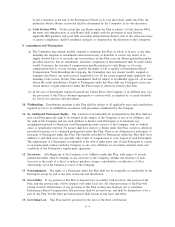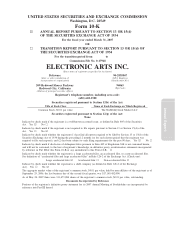Electronic Arts 2007 Annual Report Download - page 81
Download and view the complete annual report
Please find page 81 of the 2007 Electronic Arts annual report below. You can navigate through the pages in the report by either clicking on the pages listed below, or by using the keyword search tool below to find specific information within the annual report.
Advertising. We derive revenue from advertising in our games and on our websites.
Competition
We compete in the entertainment industry for the leisure time and discretionary spending of consumers with
other forms of media, such as motion pictures, television, social networking and music. Our competitors vary
in size and cost structure from very small companies with limited resources to very large, diversified
corporations with greater financial and marketing resources than ours. For example, we compete with venture
capital funded start-ups, traditional independent video game publishers, hardware and software manufacturers,
casual entertainment websites, social networking websites, mobile games developers, foreign games developers
and large media companies. We also compete with satellite radio, traditional radio and all other forms of
entertainment.
Our business is characterized by the continuous introduction of innovative new titles and the development of
new technologies. Competition is also based on product quality and features, timing of product releases,
brand-name recognition, quality of in-game content, access to distribution channels, effectiveness of marketing
and price.
In addition to competing for product sales, we face heavy competition from other software game companies
and large media companies to obtain license agreements granting us the right to use intellectual property
included in our products. Some of these content licenses are controlled by the diversified media companies,
which, in some cases, have decided to publish their own games based on popular entertainment properties that
they control, rather than licensing the content to a software game company such as us. See “Intellectual
Property” below.
Sales of Packaged Goods
The market for our packaged goods products is also characterized by significant price competition and we
regularly face pricing pressures from our competitors. These pressures have, from time to time, required us to
reduce our prices on certain products. Our experience has been that software game prices tend to decline once
a generation of consoles has been in the market for a significant period of time due to the increasing number
of software titles competing for acceptance by consumers and the introduction of new consoles. As our
industry has transitioned to a new generation of consoles over the past two years, we have experienced this
kind of price erosion with respect to games for the prior generation of consoles (e.g., PlayStation 2, Xbox and
Nintendo GameCube).
For sales of packaged goods, we compete directly with Sony, Microsoft and Nintendo, each of which develop
and publish software for their respective console platforms. We also compete with numerous companies which,
like us, develop and publish software games that operate on their consoles. These competitors include
Activision, Atari, Capcom, Koei, Konami, LucasArts, Midway, Namco, Sega, Take-Two Interactive, THQ and
Ubisoft, among others. As discussed above, diversified media companies such as Fox, Disney, Time Warner,
Viacom and Vivendi are also expanding their software game publishing efforts.
Sales for Cellular Handsets
The wireless entertainment applications market segment, for which we develop and publish games, ring tones
and wallpapers for cellular handsets, is highly competitive and characterized by frequent product introductions,
evolving wireless platforms and new technologies. As demand for applications continues to increase, we
expect new competitors to enter the market and existing competitors to allocate more resources to develop and
market applications. As a result, we expect competition in the wireless entertainment market segment to
intensify.
The current and potential competition in the wireless entertainment applications market segment includes
major media companies, traditional video game publishing companies, wireless carriers, wireless software
providers and other companies that specialize in wireless entertainment applications. We also compete with
wireless content aggregators, who pool applications from multiple developers (and sometimes publishers) and
Annual Report
7
























